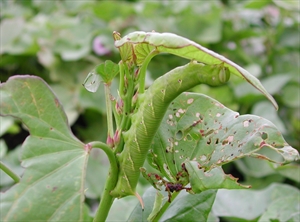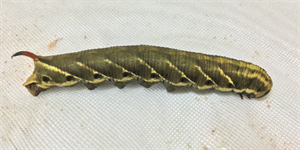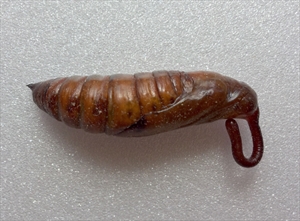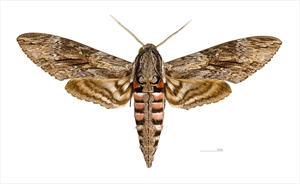Sweet potato hornworm, Convolvulus hawk moth
Pacific Pests, Pathogens and Weeds - Online edition
Pacific Pests, Pathogens & Weeds
Sweetpotato hornworm (027)
Agrius convolvuli. It is a member of the Sphingidae.
Asia, Africa, Europe, Oceania. It is recorded from Australia, American Samoa, Cook Islands, Federated States of Micronesia, Fiji, French Polynesia, Guam, Kiribati, Marshall Islands, New Caledonia, New Zealand, Niue, Northern Mariana Islands, Palau, Papua New Guinea, Samoa, Solomon Islands, Tokelau, Tonga, Tuvalu, and Vanuatu.
Sweetpotato is the main host, but it may also occur on eggplant, capsicum, tomato, and legumes.
The caterpillars do the damage. They eat the leaves, often right down to the leaf stalk. Frequently, they are found at the shoot tip, preferring young succulent leaves.
The greenish eggs, which are spherical, measuring 1-2 mm diameter, are laid singly on the leaves and stems. They hatch in about 4 days, producing caterpillars that vary from green to brown, occasionally yellow, with diagonal pale yellow lines along their sides, prominent spots and a distinctive horn (Photos 1&2). They reach 95 mm in length. There are five stages; the later stages do the most damage, feeding at night. The caterpillars are mature in 25 days or less, depending on the temperature.
The pupae are found in the soil under the plants (Photo 3). They are reddish brown with a prominent proboscis or 'trunk', which is curved downward and looks like a jug handle.
Adults emerge from the pupae in 25 days or less; they are large greyish-brown hawk moths, with black lines on the wings and pink markings on the abdomen (Photo 4). The wingspan is 8-12 cm. The moth has a very long proboscis, longer than the body, and is able to feed from long trumpet-shaped flowers, and to do that in flight.
If populations are high, the caterpillars will eat all the leaves. Severe defoliation will affect yield, especially if it occurs when plants are young. Outbreaks are not common; Agrius is usually under control by its natural enemies.
Look for large holes in the leaves, and faeces ("droppings") of the caterpillar on the young leaves. The size of the mature caterpillars and the horn are distinguishing features of this species.
NATURAL ENEMIES
Populations of the sweet potato hornworm are usually kept in check by a number of parasitoids and predators. Among the important egg parasites are minute wasps, Trichogramma spp., while Sycanus sp., a large reduviid (predatory insect), and a tachinid fly feed on the larvae.
CULTURAL CONTROL
Before planting:
- Do not make a garden of sweetpotatoes next to one where there has been a major outbreak; there may be pupae in the ground which will produce adults to infest the new planting.
During growth:
- Handpick the larvae; this can be quite effective in small areas.
- If there are large numbers, allow chickens into the garden.
After harvest:
- Collect the vines and other debris and burn them, especially if caterpillars from an outbreak still remain on the vines.
CHEMICAL CONTROL
Pesticides are not recommended as they disrupt the action of the egg and larval parasites. The hornworm is usually controlled by natural enemies, and pesticides will kill them and make matters worse. However, there are times when infestations become very severe, and pesticides may be needed. In this case:
- Use plant-derived products, such as neem, derris, pyrethrum and chilli (with the addition of soap), or synthetic products that contain disease-causing organisms, such as spinosad (Success) and Bt - Bacillus thuringiensis var. kurstaki).
- Note, a variety of Derris, brought many years ago to Solomon Islands from Papua New Guinea, is effective as a spray. It contains rotenone, an insecticide, so it should be used with caution. There may be varieties of Derris (fish poisons) in your country that can be tried (see Fact Sheet no. 56).
- Synthetic pyrethroids are likely to be effective, but will also kill natural enemies.
____________________
When using a pesticide, always wear protective clothing and follow the instructions on the product label, such as dosage, timing of application, and pre-harvest interval. Recommendations will vary with the crop and system of cultivation. Expert advice on the most appropriate pesticide to use should always be sought from local agricultural authorities.
AUTHORS Helen Tsatsia & Grahame Jackson
Information (and Photo 2) from O'Sullivan J et al . Sweetpotato DiagNotes: A diagnostic key and information tool for sweetpotato problems. (http://keys.lucidcentral.org/keys/sweetpotato/key/Sweetpotato%20Diagnotes/Media/Html/FrontPage/FrontPage.htm). Photo 3 Wikipedia. (http://en.wikipedia.org/wiki/Agrius_convolvuli).
Produced with support from the Australian Centre for International Agricultural Research under project PC/2010/090: Strengthening integrated crop management research in the Pacific Islands in support of sustainable intensification of high-value crop production, implemented by the University of Queensland and the Secretariat of the Pacific Community.







